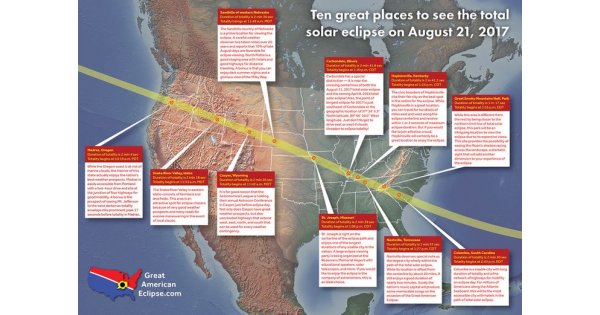The 2024 Total Solar Eclipse: Start, Peak, and End Times
The 2024 total solar eclipse will be visible across North America today. The eclipse will start, peak, and end at different times, depending on your location along the path of totality [1].
Start Times:
- The total solar eclipse is expected to first make landfall near the city of Mazatlán, Mexico, at around 9:51 a.m. MT [2].
- It will then cross over the U.S.-Mexico border into Texas, emerging over Eagle Pass at 12:10 p.m. CT.
- In Dallas, the partial eclipse will first become visible at 12:23 p.m. CT.
- The eclipse will then continue through Oklahoma and Arkansas, starting in Little Rock at 12:33 p.m. CT [2].
- Cleveland will see the beginning of the eclipse at 1:59 p.m. ET [2].
- Darkness will start spreading over the sky in Buffalo, New York, at 2:04 p.m. ET [2].
- The eclipse will reach northwestern Vermont, including Burlington, at 2:14 p.m. ET.
- Parts of New Hampshire and Maine will also experience the eclipse before it reaches the Canadian mainland at 3:13 p.m. ET [2].
Peak Times:
- The peak of totality will occur at different times for cities within the path of totality and those outside.
- Mazatlán, Mexico, will experience totality at 11:07 a.m. PT.
- Dallas will see the moon fully cover the sun at 1:40 p.m. CT [2].
- Little Rock will start to see the full eclipse at 1:51 p.m. CT [2].
- Cleveland will experience totality at 3:13 p.m. ET.
- Buffalo will have totality at 3:18 p.m. ET.
- Burlington will witness totality at 3:26 p.m. ET.
- Outside the path of totality, Washington, D.C., will have 87.4% of the sun eclipsed at 3:20 p.m. ET.
- Chicago will have maximum coverage of 93.9% at 2:07 p.m. CT.
- New York City will see 89.6% coverage at 3:25 p.m. EDT.
- Detroit will experience a near-total eclipse with 99.2% maximum coverage at 3:14 p.m. ET.
- Boston will see 92.4% coverage at 3:29 p.m. ET.
End Times:
- The eclipse will leave continental North America from Newfoundland, Canada, at 5:16 p.m. NT [3].
- In Mazatlán, the eclipse will be over by 12:32 p.m. PT.
- Dallas will see the eclipse end at 3:02 p.m. CT [2].
- Little Rock will experience the end of the eclipse at 3:11 p.m. CT [2].
- Cleveland will reach the end of totality at 4:29 p.m. CDT [2].
- Buffalo will conclude the eclipse at 4:32 p.m. ET [2].
- Burlington will see the eclipse end at 4:37 p.m. ET [2].
- Chicago will have the eclipse end at 3:21 p.m. CT [2].
- Washington, D.C., will reach the end of the eclipse at 4:32 p.m. ET [2].
- New York City will conclude the eclipse at 4:36 p.m. ET [2].
- Detroit will see the partial eclipse disappear at 4:27 p.m. ET.
- Boston will have the eclipse end at 4:39 p.m. ET [2].
Total Duration:
The total solar eclipse will last for about 5 hours, from the time the partial eclipse first appears on Earth to its final glimpses before disappearing thousands of miles away [4]. The length of totality at different points along the path will vary. The longest duration of totality will be 4 minutes and 28 seconds, northwest of Torreón, Mexico [4]. Near the center of the path, totality will last for the longest periods of time [4]. Spectators will observe totality for much longer today than during the 2017 eclipse, with the longest stretch of totality lasting 2 minutes and 32 seconds [4].
Longest Solar Eclipse Duration:
The longest known totality for a solar eclipse was 7 minutes and 28 seconds in 743 B.C. However, NASA predicts that this record will be broken in 2186 with a 7 minute, 29 second total solar eclipse. The next total solar eclipse visible from parts of the U.S. after 2024 will occur on August 23, 2044 [5].





